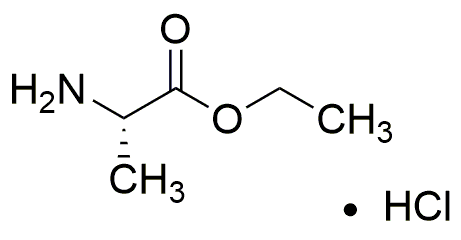L-Alanine ethyl ester hydrochloride is widely utilized in research focused on:
- Pharmaceutical Development: This compound serves as an important intermediate in the synthesis of various pharmaceuticals, particularly in the development of amino acid derivatives that can enhance drug efficacy.
- Biochemical Research: It is frequently used in studies related to protein synthesis and metabolism, providing insights into amino acid behavior in biological systems.
- Food Industry: As a flavor enhancer, it is incorporated into food products to improve taste, appealing to manufacturers looking to create more palatable options.
- Cosmetic Formulations: The compound is utilized in skincare products for its moisturizing properties, making it a valuable ingredient for formulators aiming to improve skin hydration.
- Animal Nutrition: It is added to animal feed to promote growth and improve overall health, addressing the needs of livestock producers seeking to enhance feed efficiency.
General Information
Properties
Safety and Regulations
Applications
L-Alanine ethyl ester hydrochloride is widely utilized in research focused on:
- Pharmaceutical Development: This compound serves as an important intermediate in the synthesis of various pharmaceuticals, particularly in the development of amino acid derivatives that can enhance drug efficacy.
- Biochemical Research: It is frequently used in studies related to protein synthesis and metabolism, providing insights into amino acid behavior in biological systems.
- Food Industry: As a flavor enhancer, it is incorporated into food products to improve taste, appealing to manufacturers looking to create more palatable options.
- Cosmetic Formulations: The compound is utilized in skincare products for its moisturizing properties, making it a valuable ingredient for formulators aiming to improve skin hydration.
- Animal Nutrition: It is added to animal feed to promote growth and improve overall health, addressing the needs of livestock producers seeking to enhance feed efficiency.
Documents
Safety Data Sheets (SDS)
The SDS provides comprehensive safety information on handling, storage, and disposal of the product.
Product Specification (PS)
The PS provides a comprehensive breakdown of the product’s properties, including chemical composition, physical state, purity, and storage requirements. It also details acceptable quality ranges and the product's intended applications.
Certificates of Analysis (COA)
Search for Certificates of Analysis (COA) by entering the products Lot Number. Lot and Batch Numbers can be found on a product’s label following the words ‘Lot’ or ‘Batch’.
*Catalog Number
*Lot Number
Certificates Of Origin (COO)
This COO confirms the country where the product was manufactured, and also details the materials and components used in it and whether it is derived from natural, synthetic, or other specific sources. This certificate may be required for customs, trade, and regulatory compliance.
*Catalog Number
*Lot Number
Safety Data Sheets (SDS)
The SDS provides comprehensive safety information on handling, storage, and disposal of the product.
DownloadProduct Specification (PS)
The PS provides a comprehensive breakdown of the product’s properties, including chemical composition, physical state, purity, and storage requirements. It also details acceptable quality ranges and the product's intended applications.
DownloadCertificates of Analysis (COA)
Search for Certificates of Analysis (COA) by entering the products Lot Number. Lot and Batch Numbers can be found on a product’s label following the words ‘Lot’ or ‘Batch’.
*Catalog Number
*Lot Number
Certificates Of Origin (COO)
This COO confirms the country where the product was manufactured, and also details the materials and components used in it and whether it is derived from natural, synthetic, or other specific sources. This certificate may be required for customs, trade, and regulatory compliance.


